Author: J1N, Techub News
Who would have thought that the seemingly ordinary day of October 11, 2025, would go down in history?
The cryptocurrency market experienced an unprecedented "Black Friday," with the total liquidation amount skyrocketing to over $19.1 billion within just 24 hours, setting a new historical record, leaving millions of investors with nothing overnight. Bitcoin plummeted from a high of $119,000, Ethereum crashed by 23%, and altcoins were left in ruins.
Was it a tweet from Trump that triggered all of this? Or was it a premeditated liquidation scheme?
A tweet from Trump ignites global panic
It all started on October 10, when Trump threatened to increase tariffs on China via his social media platform, and on the 11th at 5 AM, he declared a 100% tariff increase. His words were roughly:
Starting November 1, the U.S. will impose an additional 100% tariff on all imported goods from China. U.S.-China relations have deteriorated to the point where face-to-face meetings are unnecessary; we will retaliate comprehensively through financial and trade means. China's monopoly on rare earths leaves us no choice; this is to protect America's core interests.
Once the tweet was released, it directly triggered a massive sell-off in U.S. stocks, followed by a chain reaction of declines in the crypto market.
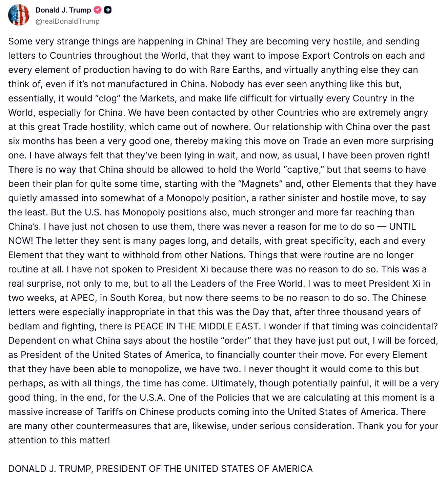
The U.S.-China friction in 2025 had already spread from technological blockades to supply chain restructuring, with the U.S. continuously ramping up pressure. However, the "100% tariff" was a severe blow, far exceeding the previous 25% or 10%, effectively doubling the cost of all Chinese export goods.
Consider the inevitable price hikes for electronic components, raw materials, and daily consumer goods. The global supply chain was already fragile, and this latest blow not only affected the U.S. and China but also dragged European and Asian markets into the vortex.
The Nasdaq index plummeted by 3.56%, marking the largest single-day drop since April; the dollar index fell by 0.57%; crude oil dropped by 4%, and copper prices also tumbled. When traditional markets become chaotic, risk assets are the first to be sacrificed, with cryptocurrencies taking the brunt.
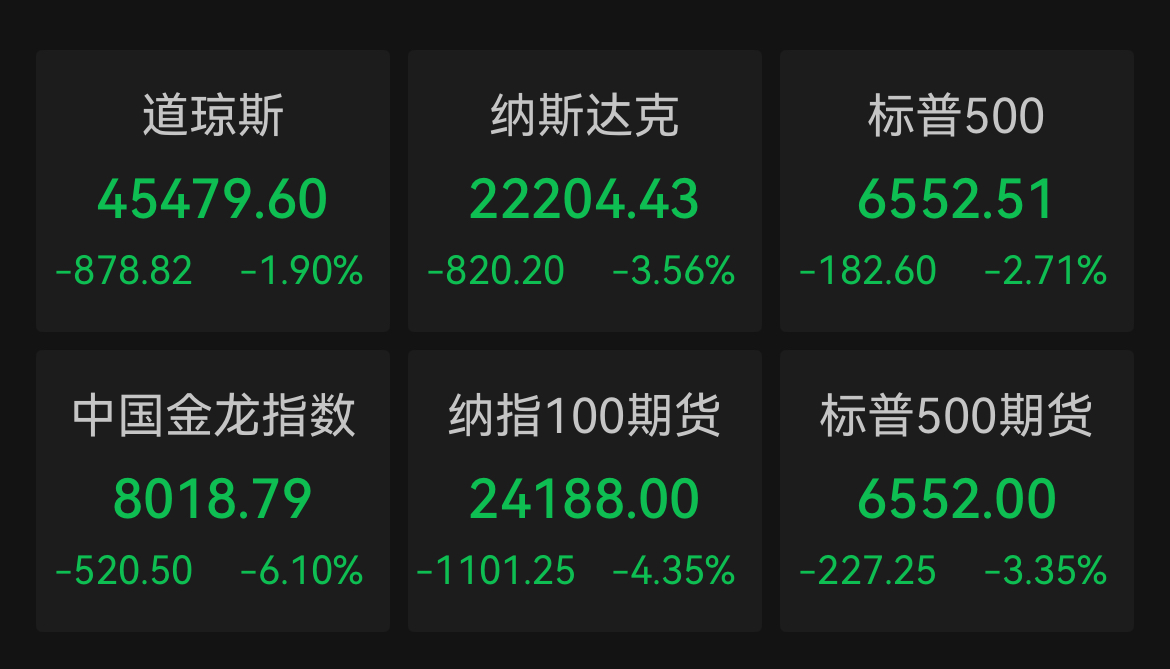
Source: Dongfang Caifu
Shortly after the tweet, Bitcoin began its free fall, crashing from a high of $119,000 to below $102,000 within hours, with a single-day drop exceeding 14%. Ethereum fared even worse, collapsing by 24%; SOL plummeted by 25%, BNB fell by 33%, and mainstream altcoins like XRP, DOGE, and SHIB saw average declines of 60% to 80%. Some illiquid small coins even dropped over 90% within minutes. The liquidation pressure was so intense that even a 1x leverage position was wiped out.
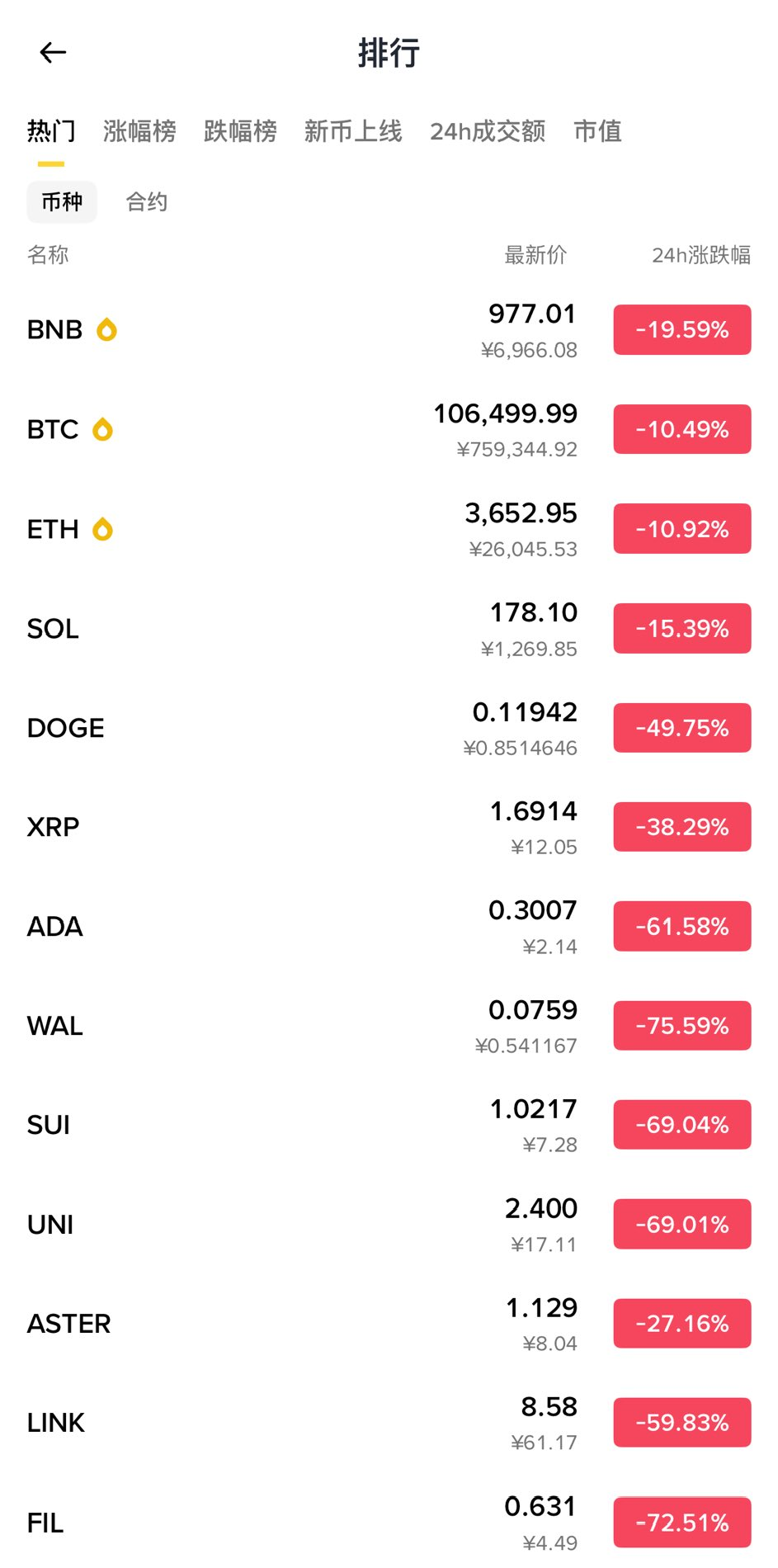
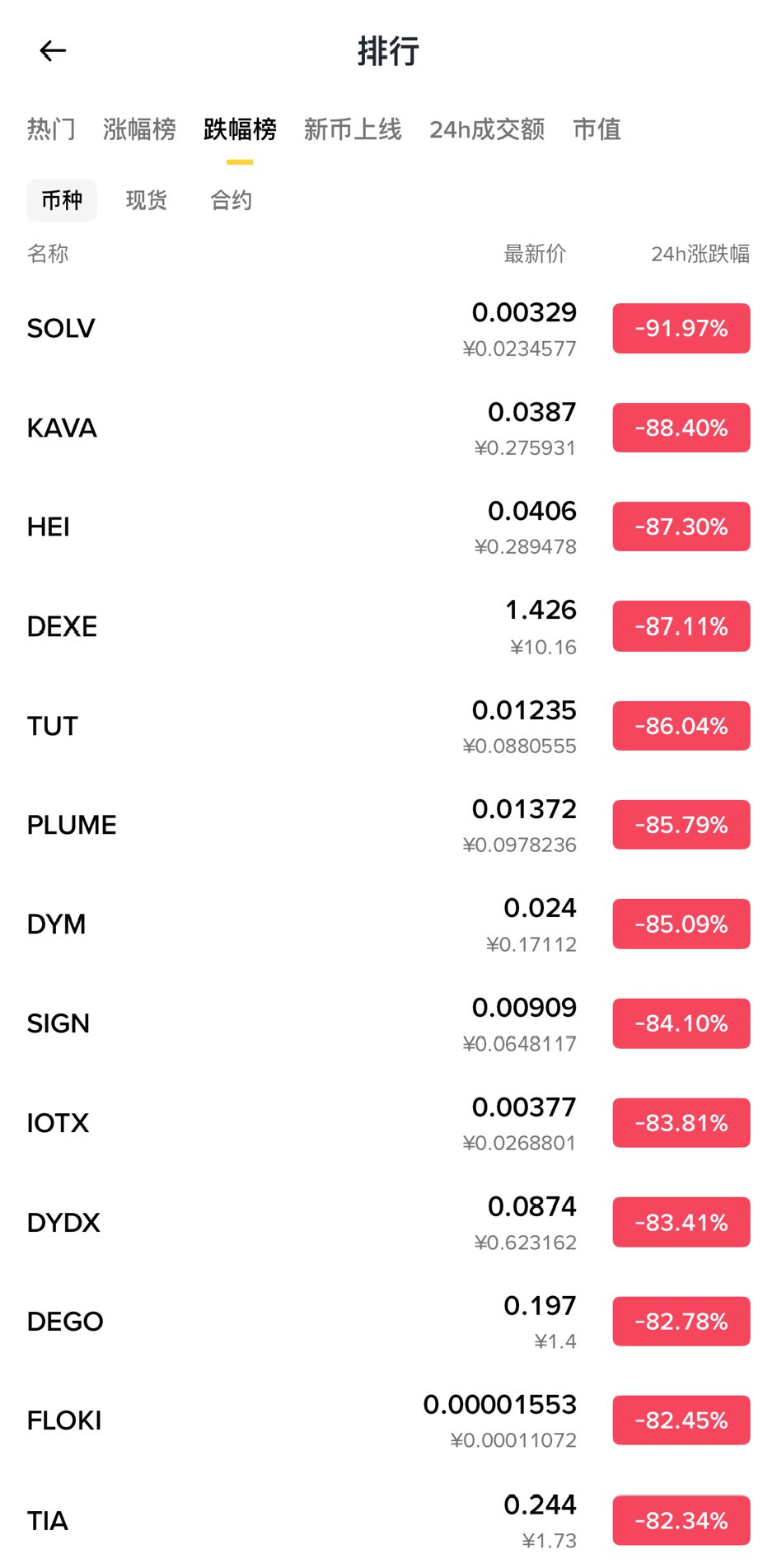
Trump's "tweet governance" is no longer a novelty, but in 2025, this strike was particularly lethal. The crypto market is now deeply interconnected with traditional finance; when U.S. stocks fall, the crypto market naturally follows suit. More critically, this tariff directly targeted China's rare earth monopoly. Rare earths are vital for high-tech industries like chips and batteries, indirectly impacting blockchain mining and hardware ecosystems.
The tweet spread virally across the globe, leading institutions and retail investors to sell off in a frenzy, creating a vicious cycle. Panic, thus, spiraled out of control within hours.
$19.1 billion in liquidations within 24 hours, setting a historical record
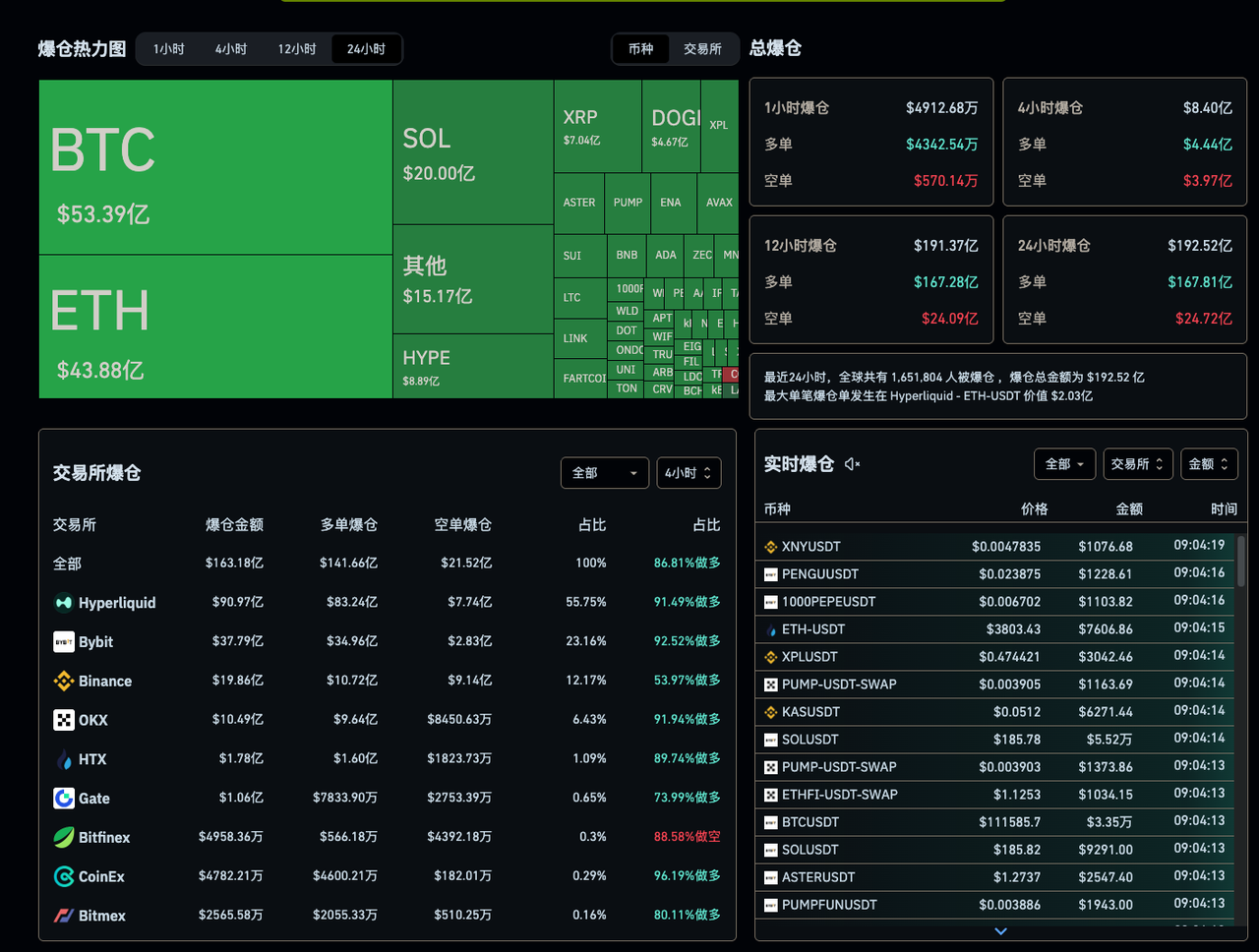
In the 24 hours following the event, the total liquidation amount across the network continued to rise, setting a new historical record in the crypto space. This time, not only was the scale massive, but it was also particularly concentrated; almost everyone who leveraged their positions was wiped out. According to Coinglass, the total liquidation amount reached $19.141 billion, once again breaking historical records, with a total of 1,621,284 people liquidated, including $16.686 billion in long positions and $2.455 billion in short positions. The largest single liquidation occurred in the ETH-USDT contract trading pair on the Hyperliquid platform, valued at $203 million. In terms of cryptocurrencies, Bitcoin saw $5.317 billion in liquidations, Ethereum $4.378 billion, SOL $1.995 billion, HYPE $888 million, and XRP $699 million.
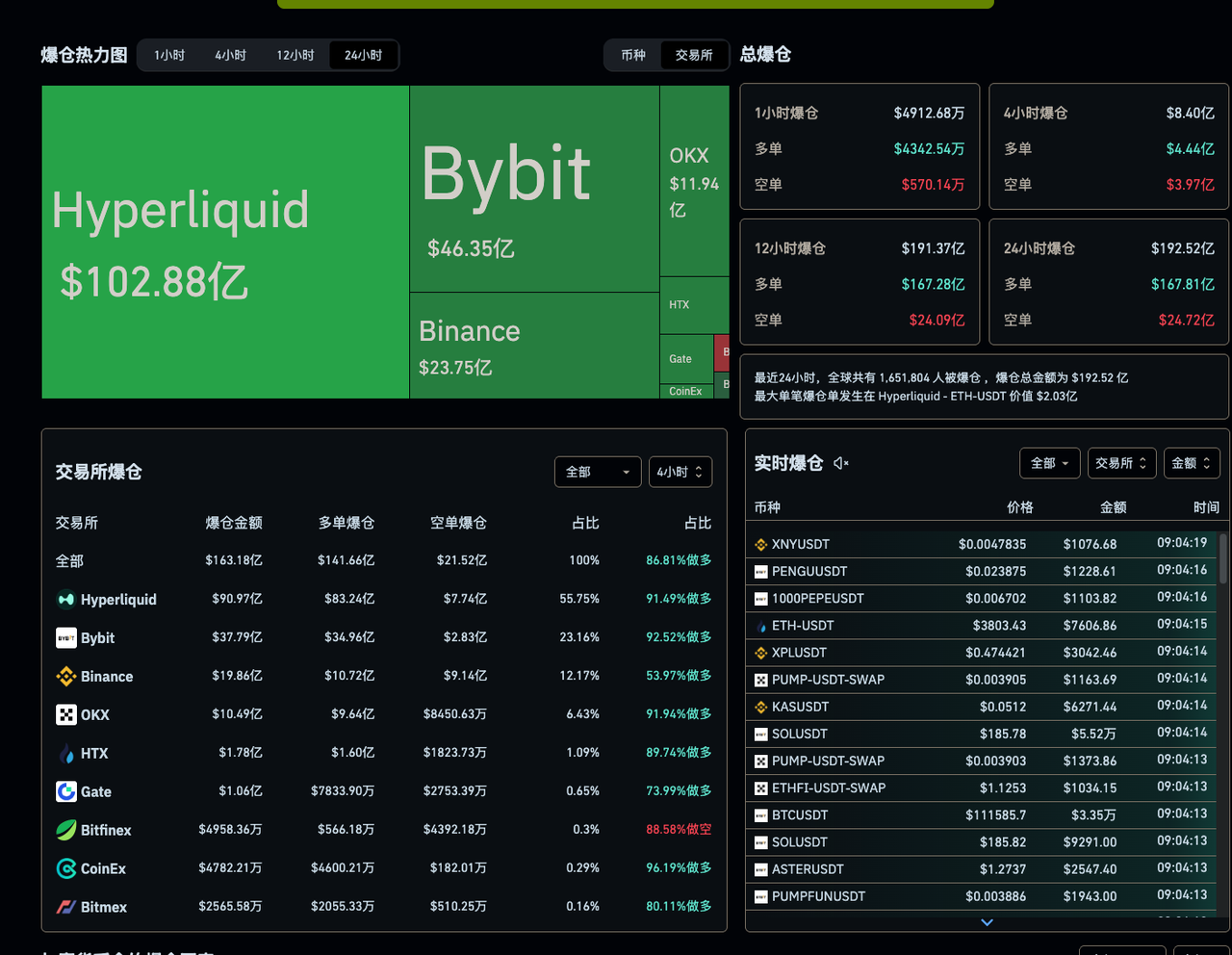
That's right, $19.141 billion! This is undoubtedly a catastrophic disaster in the history of the crypto space, even more severe than previous black swan events. Long positions accounted for the majority ($16.686 billion), indicating that in a bullish market atmosphere, everyone was chasing after rising prices, and when the black swan appeared, the entire market collapsed, leaving 1,621,284 people’s positions worthless in an instant.
The largest single liquidation occurred on the Hyperliquid platform, which is known for its high-leverage perpetual contracts and became a disaster zone this time. That $203 million ETH-USDT contract liquidation reflects the terrifying nature of leverage. Hyperliquid's HLP profited immensely from this event, skyrocketing from $80 million to $120 million, proving the scale of the liquidations.
Why was Hyperliquid so severely affected? Because it supported synthetic stablecoins like USDe as collateral, and USDe decoupled during the crash. USDe is a product of Ethena Labs, with a market cap of $14 billion, originally relying on delta-neutral hedging to maintain stability by holding Ethereum spot while shorting equivalent perpetual contracts. However, Trump's tweet triggered a 24% drop in Ethereum, turning the funding rate negative, causing the protocol to shift from profit to loss, and the value of collateral shrank. A large institution using USDe for cross-margin on Binance directly liquidated and sold off, causing the price of USDe to plummet to $0.6. In a chain reaction, the circular loan positions of lending protocols were all liquidated, creating a death spiral.
Before the U.S. stock market closed (at 4 AM), many people used 3x, 5x, or even higher leverage to go long, thinking the worst was over, only to be blindsided again around 5 AM, leading to total liquidation overnight. On Hyperliquid, some users lost millions of dollars in just 15 minutes. The entire process resembled a game of dominoes: stablecoins decoupled, collateral shrank, automatic liquidations occurred, selling intensified, leading to more decoupling, and CEX outages made operations impossible.
Upon waking up, the cries of despair were everywhere.
Liquidation data kept pouring in, and the crypto community was in complete chaos. Twitter, Reddit, Telegram, Discord—everywhere there were voices of lament. Many people woke up to find their account balances plummeting at a 90-degree angle. Some lamented, "With one tweet from Trump, the entire network collapsed. Last night I dreamed Bitcoin would break $120,000, and today I woke up to find it might not even hold $100,000." Others self-deprecated, "Stablecoin? Stable my ass! USDe went from $1 to $0.6, and all my retirement money is gone."

The bullish market atmosphere was too heated, and everyone forgot the risks; the temptation of high returns was too great. The circular loan strategy of USDe sounded impressive, promising annualized returns of 40%-50%, but in essence, it was leveraged gambling. The herd mentality was severe; seeing others make money led to following the trend, and when the black swan appeared, the entire army was wiped out. Institutions also suffered; they might have been traditional financial companies crossing over into crypto, using USDe as collateral. As a result, liquidity dried up, and small coin contracts were directly hit hard. Conspiracy theories abounded in the community: some said the Trump family had preemptively shorted the market, coordinating with the tariff war to reap profits; others believed it was a premeditated liquidation scheme set up by market makers.
How did the dominoes of "circular loans" fall?
On the surface, it was Trump's tweet, but in reality, it was the hidden leverage risks in the crypto space. The circular loan strategy represented by USDe finally ignited the crisis. It was like a carefully set trap; behind the high returns lay a deadly pitfall.
USDe is a synthetic dollar from Ethena Labs, with a market cap of $14 billion, ranking third among stablecoins. It promised annualized returns of 12%-15%, far exceeding the low interest of USDT. How did it earn? Through delta-neutral hedging: holding Ethereum spot while shorting equivalent perpetual contracts to earn funding rates. In a bull market, the rates are positive, allowing the protocol to profit and distribute to users. Many were not satisfied with this and engaged in circular loans: using USDe as collateral to borrow USDT, then depositing it back into USDe to earn interest, repeating the process, which could amplify the principal fourfold, with annualized returns soaring to 40%-50%. It sounded low-risk and high-reward, attracting hundreds of billions in funds, quickly filling the deposit pool.
However, Trump's tweet shattered this balance. Ethereum plummeted by 16%, turning the rates negative, causing the protocol to shift from profit to loss, and the value of collateral shrank. USDe decoupled, and its price halved to $0.6. The circular loan situation worsened: "The smart contract detected insufficient collateral and automatically sold USDe to repay debts, further driving down the price, triggering more liquidations, creating a death spiral." As prices fell, liquidations led to further price drops.
Market makers using USDe as contract collateral, even with 1x leverage, effectively faced passive leverage after the value shrank. As liquidity dried up, spreads widened, and small coins crashed by 80%-90%. Hyperliquid's HLP treasury made a killing, proving the terrifying scale of the liquidations. Crypto investor Dovey speculated that the large institution's liquidation on Binance was the starting point: cross-margin operations triggered a wave of sell-offs.
When everyone is chasing high returns, the risks are often the greatest. This time, the combination of leverage and stablecoins magnified a localized crisis into a systemic collapse. Why, knowing there are pitfalls, do so many still rush in? Because of human greed, always believing they are the exception.
From 312 to 519, and then to the shadow of FTX.
The collapse of the crypto market is never a new phenomenon, and the October 11 incident inevitably brings to mind past black swan events.
March 12, 2020, May 19, 2022, and the FTX collapse—each time feels like history repeating itself, yet the lessons seem to be forgotten.
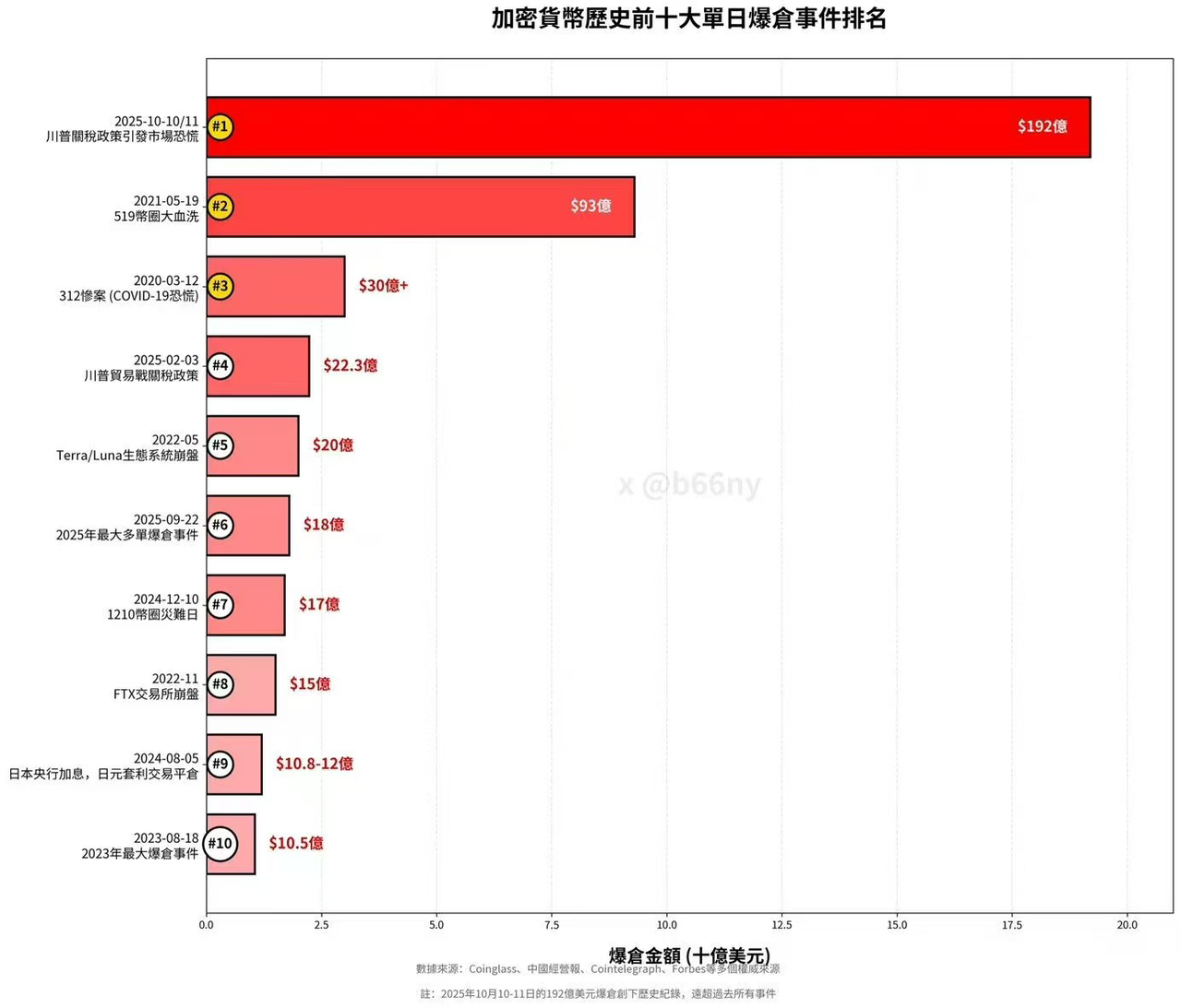
On March 12, 2020, the COVID-19 pandemic erupted globally, leading to a collapse in traditional markets, which in turn affected crypto. Bitcoin plummeted from $8,000 to $3,800 overnight, a drop of over 50%; Ethereum fell from $200 to $90; altcoins were halved on average. Billions of dollars were liquidated within 24 hours, setting a record at the time. A global panic sell-off ensued, leading to a liquidity crisis. Starting from the low point, Bitcoin took about three months to return to $8,000, and then surged to over $60,000 in 2021.
On May 19, 2022, the Luna/UST disaster struck, marking a nightmare for algorithmic stablecoins. UST promised a 20% annual return, attracting hundreds of billions in funds, but after decoupling, Luna plummeted from $119 to $0.0001, evaporating $60 billion in market value. Hundreds of billions were liquidated, the Terra ecosystem collapsed, affecting DeFi and NFTs. Bitcoin took over six months to recover from a low of $30,000, eventually leading to the bull market in 2023. Ethereum dropped from $2,000 to $800, slowly climbing back.
In November 2022, the FTX collapse occurred, with the exchange giant FTX going bankrupt and founder SBF arrested. SBF misappropriated user funds for trading and leveraged operations, leading to the collapse. Hundreds of billions were liquidated, impacting the SOL ecosystem (linked to Alameda), and the market lost hundreds of billions in value. However, the crypto market was already in a bear phase, and this event deepened the bear market, which only stabilized six months later, leading to the bull market in 2023.
The October 11 incident feels like a hybrid: the decoupling of USDe resembles Luna's death spiral; the leverage liquidation is akin to the events of March 12 and May 19; institutional liquidations echo the FTX collapse. Yet the unchanging core remains the high returns as bait, with extreme circumstances exposing the fragility of the mechanisms, causing a single crisis to ripple through the entire market. The difference is that USDe had collateral and did not completely go to zero; it occurred in a time of stricter regulation. History teaches us that leverage is like drug addiction, providing enjoyment while leading to self-destruction.
Surviving is always more important than making money.
The October 11 crash was not just a price plunge; it was a complete reshaping of the ecosystem. It also exposed the vulnerabilities of stablecoins. The high-yield USDe was essentially a risk hedge, and the circular loans combined with leverage turned into a gamble. What about regulation? In 2025, the SEC tightened its grip, but black swans still cannot be prevented. In the long run, this incident will push for stronger audits of stablecoins and tighter leverage limits.
From a global perspective, the escalation of the tariff war and the U.S.-China rivalry will increase mining costs but may also accelerate decentralization, with mining operations shifting to the Middle East or Latin America.
For most people in the crypto space, that night was the darkest moment of their lives. Even some optimistic industry observers felt a hint of despair. Greed, luck, and herd mentality are human weaknesses that are always magnified in bull markets. The crypto space is like life; surviving is always more important than making money. A tribute to Buffett's saying, "Only when the tide goes out do you discover who's been swimming naked."
免责声明:本文章仅代表作者个人观点,不代表本平台的立场和观点。本文章仅供信息分享,不构成对任何人的任何投资建议。用户与作者之间的任何争议,与本平台无关。如网页中刊载的文章或图片涉及侵权,请提供相关的权利证明和身份证明发送邮件到support@aicoin.com,本平台相关工作人员将会进行核查。




